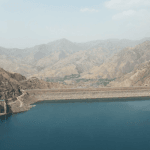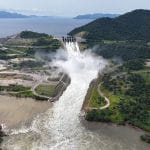COPENHAGEN, Denmark – The blades of the 20 turbines of the Middelgrunden offshore windfarm, off the coast of Copenhagen, rotated slowly as the boat ‘Langø’ circled around the long line of massive shafts with the Copenhagen harbour and the bridge connecting Denmark to Sweden outlined in the far distance.
While the Middelgrunden windfarm is no longer considered big compared to the new windfarms in Denmark and around the world, it is one of the first offshore windfarms and the world’s largest when it was first inaugurated in 2000-2001. It has a capacity of 40 MW and the park consists of 20 Bonus turbines each with a power of 2 MW.
The Middelgrunden windfarm provides 3% of the electricity consumption of Copenhagen. Ten of the wind turbines are owned by the energy company Hofor and the remaining ten belong to a co-operative that offers Copenhagen citizens a share of the turbines.
“We’re looking to repower the farm. We’re also looking at new developments,” Gordon Pedersen, technical project director offshore wind at Hofor, told New Europe on the boat on November 27 with the blades rotating in the background under the cloudy Danish sky. “It was built in 2000 and it has now been operating for nearly 20 years,” he said, adding that the Hofor, which is the windfarm’s new owner, plans to repower the windfarm to generate more electricity.
“In Denmark we have something like 42% of our energy production is covered by offshore wind. But this wind farm is providing something like 9 KW a year so it’s not a huge production. It’s nothing compared to the bigger wind farms,” Pedersen said. “This one is the only one we have in operation right now but we’re developing wind farms,” he added.
“Our company, we want to produce as much green energy that is produced in Copenhagen and greater Copenhagen. Because Copenhagen wants to be carbon dioxide (CO2) neutral so Copenhagen wants to establish as much green generation as consumed in the greater Copenhagen area,” the Hofor technical director said on in the cold Danish morning.
Hofor’s plans to increase its production of green energy in Denmark, which is a forerunner in offshore wind energy, come as European Commission President Ursula von der Leyen, whose College of Commissioners was officially endorsed by the Parliament on November 27, is about to unveil her first landmark climate policy package.
The plans are also in line with a new report from WindEurope, which was released in Copenhagen on November 26, showing that the European Commission’s big goals for offshore wind – between 230 and 450 GW by 2050 – are achievable provided the right investments in electricity grids and governments take the right approach to maritime spatial planning.
According to WindEurope, the report is a remit from the Energy Ministers of the 10 ‘North Seas’ countries who coordinate their work on offshore wind with each other and the Commission. The report examines where 450 GW of offshore wind could be deployed most cost-effectively around Europe, bearing in mind there is only 20 GW today. 450 GW of offshore wind is part of a European Commission scenario to deliver climate neutrality by 2050.
The report concludes that 212 GW should be deployed in the North Sea, 85 GW in the Atlantic, including the Irish Sea, 83 GW in the Baltic, and 70 GW in the Mediterranean and other Southern European waters. This reflects the relative wind resources, proximity to energy demand and the location of the supply chain.
Meanwhile, a new report from the European Technology & Innovation Platform on Wind Energy (ETIPWind), released on 27 November in Copenhagen, said targeted Research & Innovation is needed to accelerate the large-scale deployment of cost-competitive wind energy and support the existing European supply chains.
According to the ETIPWind report, Europe needs a rapid scale up of wind energy to help keep global warming well below 2 degrees Celsius and deliver on its Paris Climate Agreement commitments. To deliver on its Climate and Energy objectives, Europe needs strong industrial policies and research programmes to further improve wind energy technology and continue to drive down costs.
Targeted support in Research & Innovation will also strengthen supply chains, create local jobs and boost the global leadership of the European wind industry, the report said, adding that by 2050, wind could supply 50% of Europe’s electricity and be the engine of the incoming EU Commission’s Green Deal.
Back on the Langø’ boat off the coast of Copenhagen, Pedersen stressed that the future looks green, saying: “We will have to build nearshore and build farshore.”
follow on twitter @energyinsider







